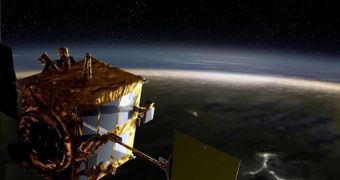The Akatsuki space probe may have failed to achieve orbital insertion around Venus due to a collision with an impact object, or because one of its engine nozzles may have malfunctions, say investigators in Japan, quoted by news reports.
The spacecraft had spent more than 6 months traveling through space before arriving at Venus on Monday evening (December 6), at 6:49 pm EST (2349 GMT).
At that time, it was scheduled to begin a specific type of thruster firing, which was to help it decelerate and achieve insertion into a stable orbit around its target. The probe was supposed to spend two years orbiting Venus.
According to officials at the Japan Aerospace Exploration Agency (JAXA), Akatsuki will pass close enough to allow experts to try for another orbital insertion maneuver in late 2016 or early 2017.
The scientists also announced that they would like to try again at that time, although no one can say for sure what condition the probe will be in at that time.
“While we set up a new investigation team to study the cause and countermeasures, we will also review the Venus orbit injection plan again to take the next opportunity in six years when the Akatsuki flies closest to Venus,” JAXA explains in a statement.
The $300 million spacecraft passed within 550 kilometers of the surface of the planet on Monday, and plans were to fire its thrusters until the probe slowed down sufficiently to allow for Venus' gravitational pull to take control.
Its engines were supposed to be fired in a specific sequence to achieve this, taking the spacecraft out of communications range for around 22 minutes. The blackout instead lasted for 90 minutes.
Reports in the Japanese newspaper Mainichi Daily News indicate that the Akatsuki engines fired for about 2 to 3 minutes, rather than the planned 12. As such, the spacecraft was not sufficiently decelerated to achieve orbital insertion.
An article published in the journal Nature shows that the spacecraft exhibited peculiar behavior during the maneuvers, entering a safe mode meant to prevent it from suffering harm.
The same document shows that Akatsuki – whose name means dawn in Japanese – started spinning before the event was triggered, which implies that it was either hit by something, or that one of its engine nozzles malfunctioned.
This is the second Japanese orbiter ever sent to another planet, and also the second to fail, after the Nozomi orbiter sent to Mars in 2003 didn't manage to achieve orbital insertion.
That mission is currently still active, but located in a 2-year orbit around the Sun, Space reports.
Representatives from various international groups and space organizations expressed their support for JAXA after news of the failure broke out.
“The Planetary Society regrets that the innovative Akatsuki spacecraft seems to have missed its opportunity to lock into an orbit of Venus,” says the group's executive director, Bill Nye.
“Although Akatsuki has already accomplished some remarkable things on its voyage, this setback reminds us how difficult space exploration can be,” he adds.
At this point, the only active spacecraft around our neighboring planet is the European Space Agency's (ESA) Venus Express probe.

 14 DAY TRIAL //
14 DAY TRIAL //